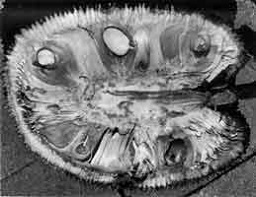In the late 1960's,
at the Brisbane R.N.A. Exhibition, I saw a very large green "fruit"
with small spikes all over the skin.
Upon
asking about the fruit and listening to what others said, I was left
with the impression that one could eat parts of the fruit, but more
often it was fed to pigs.
Well, many jakfruits later, the impression of size is still with me but
the uses of the fruit are far greater.
With
the recent plantings of many thousands of jakfruit trees, there will be
a good supply (possibly over-supply) within a few years. Most people I
have talked to consider the jakfruit tree a good windbreak tree that
will possibly produce some saleable fruit. They have not given much
thought to selection; usually planting the seeds of any fruit they
found.
I mentioned earlier that there were many uses for
jakfruit, but there are also many different types. The characteristics
of some fruits make them unsuitable for some recipes. Ammy Setu, a Fiji
Indian friend of mine often referred to various trees as good for curry
and others not so. After eating a few curries, I became interested and
compared a few fruits from different trees. What a surprise; some
fruits made a very good full-body curry, while others were bitter: very
bitter, only good for chook food.
Aril characteristics of ripe
jakfruit also vary considerably. Very soft arils are good for milk
shakes, while the crisp type are more useful stuffed with dates and
nuts or similar.
Before you plant jakfruit trees, consider where you intend selling the
fruit, then select your trees carefully.
WINDBREAK
Select
light-cropping trees with good tap roots. Remember that a root-bound
tree full of jakfruit in a strong wind, with soft wet soil, is not much
of a windbreak - they tend to fall over.
VEGETABLE
Size of
fruit is not as important, as fruit picked for use as a vegetable is at
a very immature age and also it is often cut and sold in pieces like
pumpkin. Jakfruits for vegetable must not be of a bitter type and
preferably have a small core. The seeds of the jakfruit are a useful
vegetable. They resemble large beans when cooked. Considerably more
promotional work needs to be done on how to use the seeds, otherwise
they will be treated as waste (like most seeds).
It is advisable
to keep a bottle of household kerosene handy when preparing green
jakfruit, as kero is very effective in cleaning the sticky sap off
hands, knives and mum's kitchen table. Cooking oil and many sheets of
newspaper also help.
FRUIT
There are two basic flesh types -
A. Soft flesh. B. Crisp flesh.
Between
these extremes there is a range of flesh types. The soft flesh is
easily blended with dairy products etc., like ripe mango, whereas the
crisp flesh breaks up into small pieces in the blender which may be
useful in yoghurt and ice cream, but the flavour is not evenly
distributed. Crisp types are easy to eat fresh and can be filled or cut
up.
The rags or underdeveloped arils are the stringy, usually
bland, filler between the arils. Although this may be used from ripe
fruit, its use in jams etc. is very restricted and it is mostly
considered with the skin and core as waste. In some jakfruit types, the
rags are quite soft and full of flavour. This may be a desirable
feature to look for.

Few large seeds, thick crisp aril. The cross section of this Jakfruit
also shows a medium sized core and a thick skin.
GENERAL CHARACTERISTICS
I
purchased a number of jakfruit from a roadside stall. The shop owner
didn't know much about the fruit except that when it was soft, it was
ripe. All the fruit turned out to be some of the worst I have seen, it
was probably these fruits that first prompted me to write this article.
The
fruits were small and bumpy, that was O. K. When I opened them up, they
were all much the same, very big core, thick skin, only 8 - 12 seeds,
all very large and hardly any aril. With a recovery of about 1%, the
$3/kg became quite expensive.
Unconfirmed reports of pinks
disease and root rot affecting trees may indicate that selection or
management may be needed to reduce tree losses. Time to first fruiting
varies widely. Thirty months from seed to ripe fruit is the best I have
heard of, while some trees are over 6 years old without setting a
fruit. I consider growing conditions to be very important here.
With
grafted jakfruit trees becoming available, it is important that
characteristics of the parent tree be recorded and made available.
There
are some very good jakfruit trees available. Small round fruit, thin
skin, small core, many small seeds covered in thick bright-coloured
aril with a strong fruity flavour. These characteristics are not the
only ones that make up a good fruit but they are a guide.

